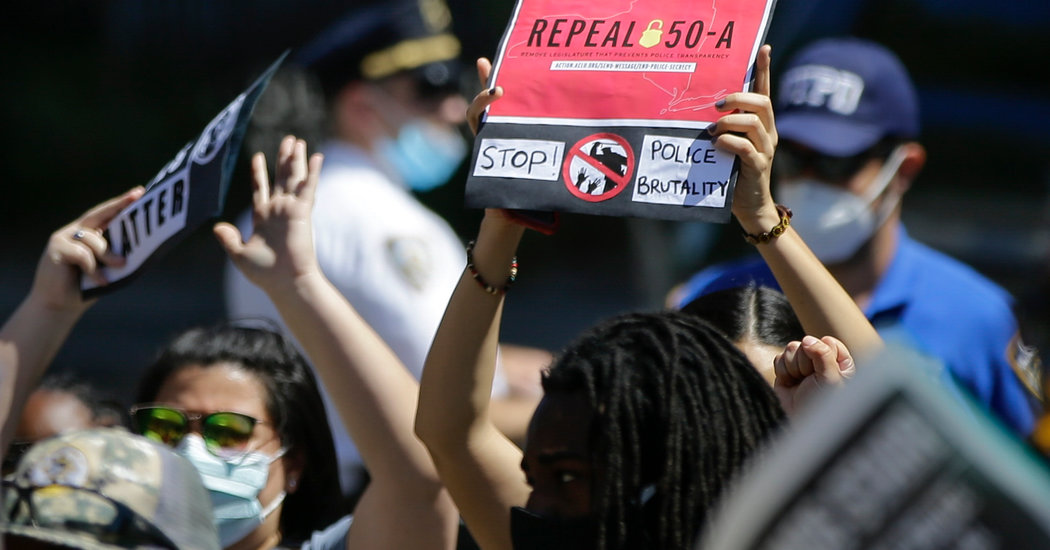Protest works.
The large street demonstrations in scores of cities and towns across the country are bringing sudden and sweeping changes to police practices and accountability.
Minneapolis is preparing to disband and rebuild its police department.
California is poised to ban the use of police chokeholds.
Dozens of cities are considering redirecting millions in taxpayer funds from America’s heavily militarized police departments to education, health care, housing and other needs of black and Hispanic neighborhoods that have been underinvested in for generations.
New York took a step toward reform with the repeal Tuesday evening of a state law known as 50-a, a decades-old measure that has allowed the police to keep the disciplinary and personnel records of officers secret. Gov. Andrew Cuomo is expected to sign the bill.
New York’s 50-a is one of the strongest police secrecy laws in the country, the spoils of the unfettered political power New York police unions have enjoyed.
For generations, the law has been used to keep officers accused of misconduct, as well as the departments they work for, from public scrutiny. To understand its tragic toll, consider some of the New Yorkers who died at the hands of officers who most likely never should have been on the job.
Eric Garner, an unarmed black man, died in 2014 of an asthma attack triggered by a banned chokehold by a New York Police Department officer with four substantiated allegations of abuse against him. The public learned of the complaints only after they were leaked.
Ramarley Graham, 18, was unarmed when he was shot and killed in his own home by another officer in the department. Leaked police records later showed that the officer, Richard Haste, had an unusually high number of complaints against him.
Activists and police reformers have fought to repeal the law for years. Just a year ago, those efforts went nowhere. The State Legislature, even under a new Democratic majority, declined to change or repeal it. Mayor Bill de Blasio, whose administration has interpreted 50-a more strictly than his predecessors, said he supported changes to the law but he did not spend the political capital to make them happen.
Despite the harm 50-a has caused, most New Yorkers were unaware of the law. So it was startling in the past week to see “Repeal 50-a” signs pop up across New York State, at the protests and elsewhere. Driving through Long Island on Sunday, I saw one car emblazoned with the phrase in electrical tape. In Brooklyn’s upscale Cobble Hill neighborhood, “Repeal 50-a!” was posted in the storefront of a local doctor’s office and in the windows of brownstones.
What changed is that people took to the streets in peaceful protest, a movement led by black New Yorkers and others who have fought for reforms for years. What made the difference was Americans watching police officers, here and across the country, beating unarmed protesters for the crime of demanding basic respect and human dignity from the departments financed by their tax dollars.
In Buffalo last Thursday, a police officer shoved a 75-year-old white protester to the ground, an incident captured in a graphic video. Several lawmakers said the incident helped galvanize crucial support for the repeal of 50-a outside New York City.
In New York State, the repeal must be the beginning of changes to policing, not the end. The violent response to largely peaceful protests has pulled back the curtain on what black Americans already knew: that local police departments across the United States, including in New York, are too often abusive and unaccountable to the very people they are supposed to serve. It is time for far-reaching reform.
Assemblyman Charles Barron spoke for many of the protesters when he said repealing 50-a was far from enough, and he called for “radical, systemic change.”
“I don’t have no more patience for gradual reform,” he said.
The Times is committed to publishing a diversity of letters to the editor. We’d like to hear what you think about this or any of our articles. Here are some tips. And here’s our email: [email protected].
Follow The New York Times Opinion section on Facebook, Twitter (@NYTopinion) and Instagram.



















